| Article ID | Journal | Published Year | Pages | File Type |
|---|---|---|---|---|
| 44247 | Applied Catalysis A: General | 2006 | 7 Pages |
The selective oxidation of benzyl alcohol to benzaldehyde with molecular oxygen in supercritical carbon dioxide over a commercial 0.5 wt.% Pd/Al2O3 catalyst was studied under continuous-flow conditions using toluene as a co-solvent. The whole range from neat CO2, toluene-modified CO2, CO2-expanded toluene to neat toluene was investigated. Adding a small amount of toluene to the feed (molar ratio toluene/alcohol of 1/1) resulted in a strikingly higher reaction rate than in neat CO2. The turnover frequency reached 2500 h−1 compared to 1500 h−1 without toluene. A too high toluene concentration led to a biphasic reaction mixture and to a remarkably lower catalytic activity (TOF 130 h−1 at a toluene/benzyl alcohol/O2/CO2 molar ratio of 16/0.8/0.4/82.8). In all cases, a strong dependence of the reaction rate on the pressure was found, which was closely related to the phase behaviour. The best catalytic activity could be achieved under monophasic conditions due to the elimination of the gas/liquid interface as uncovered by video monitoring combined with ATR-IR spectroscopy. Additional in situ infrared spectroscopic investigations showed that toluene was fully dissolved already at low pressure (120 bar), whereas higher pressure was required (150 bar) to dissolve benzyl alcohol and thus to reach a single phase. Using a higher amount of toluene (five times more toluene than alcohol) led to complete dissolution of the benzyl alcohol in the CO2/toluene mixture at 130 bar and thus to a higher catalytic activity in this region of lower pressure.
